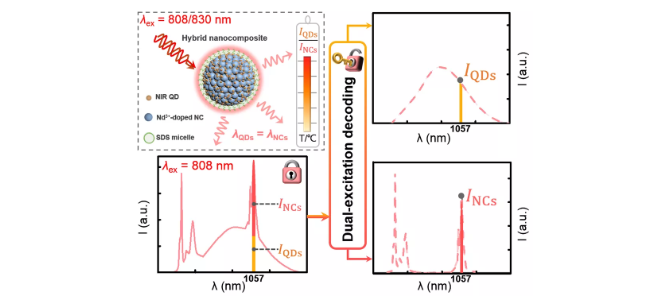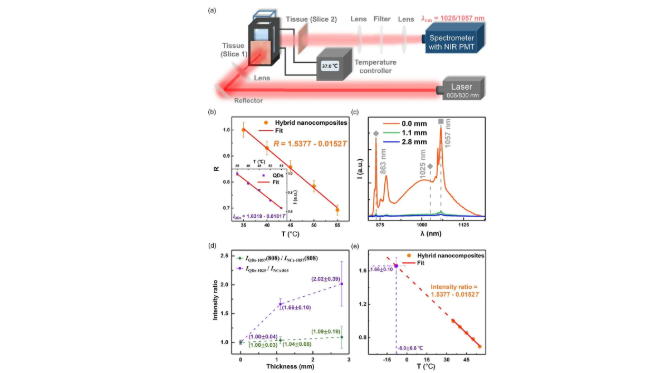
hotline:
17715390137
Tel/Wechat:
18101240246 (Technology)
0512-68565571
Email:mxenes@163.com (Sales Engineer)bkxc.bonnie@gmail.com
Scan the code to follow or search the official account on WeChat:
2D Materials Fronrier After paying attention,
click on the lower right corner to contact us,
Enter enterprise WeChat.
Professional Services Online

Near-infrared fluorescence ratio temperature sensing has the advantages of greater tissue penetration depth, lower background fluorescence interference and non-invasive detection, and therefore has broad application prospects in the field of biomedicine. In order to avoid the crosstalk of fluorescence detection signals, the traditional near-infrared fluorescence ratio temperature detection mode uses the ratio of the intensity of two non-overlapping fluorescence emission as the temperature-sensitive parameter. However, the attenuation coefficient of light in biological tissues is wavelength-dependent, so the temperature-sensitive parameter, the ratio of the intensities of two non-overlapping fluorescence emissions, is not only modulated by temperature, but also related to the attenuation coefficient and penetration of the fluorescence signal in the tissue. The depth is related. Therefore, when the traditional near-infrared fluorescence ratio temperature detection mode is used for temperature detection in biological tissues, the temperature sensitivity parameters obtained will deviate from the true value due to the attenuation of light in the tissue, resulting in temperature measurement deviations. Therefore, how to achieve accurate temperature detection in biological tissues remains a severe challenge.

Figure 1. Schematic diagram of accurate temperature detection based on dual excitation decoding strategy based on rare earth nanocrystal/quantum dot composite materials
Design and Assembly of Functional Nanostructures, Chinese Academy of Sciences/Fujian Key Laboratory of Nanomaterials Chen Xueyuan‘s team first proposed the dual excitation decoding strategy based on rare earth nanocrystal/quantum dot composite probes to achieve precise temperature detection in biological tissues (Figure 1) . First, the core-shell structure NaLuF4: Nd3+, Gd3+@NaGdF4 rare earth nanocrystals and PbS@CdS@ZnS quantum dots are self-assembled in micelles formed by amphiphilic molecules to construct rare earth nanocrystal/quantum dot composite microspheres, and Under the excitation of 808 nm laser, the ratio of the emission intensity of two Nd3+ ions and quantum dots in nanocrystals with wavelengths at 1057 nm is defined as the temperature-sensitive parameter. Subsequently, the team cleverly used the different light absorption characteristics of Nd3+ ions and quantum dots, and selected another 830 nm laser with a wavelength similar to that of the 808 nm laser and in the same path to independently excite the quantum dots in the composite to emit light, and finally pass this A dual excitation strategy separates the overlapping emission signals at 1057 nm, and calculates the ratio of emission intensity as a temperature-sensitive parameter.

Figure 2. a) In vitro simulation experiment light path diagram of temperature detection in biological tissues; b) Temperature sensitive characteristics of rare earth nanocrystal/quantum dot composite probes; c) Emission spectra of composite probes in tissues of different thicknesses; d ) The temperature-sensitive parameters of the dual excitation decoding strategy and the temperature-sensitive parameters of the traditional near-infrared fluorescence ratio-based temperature detection mode change with tissue thickness; e) When the tissue thickness is ~1.1 mm, use the traditional near-infrared fluorescence ratio-based temperature detection The temperature deviation produced by the mode reaches ~43 °C.
Furthermore, the team experimentally verified the superiority of the dual-excitation decoding strategy compared to the traditional near-infrared fluorescence ratiometric temperature detection mode in the accuracy of temperature detection in biological tissues (Figure 2). For example, when the tissue detection depth is ~1.1 mm, if the traditional near-infrared fluorescence ratiometric temperature detection mode is used, that is, the Nd3+ ion fluorescence emission at 863 nm and the fluorescence emission at 1025 nm in the rare earth nanocrystal/quantum dot composite The ratio of the fluorescence emission intensity of the quantum dots is used as the temperature-sensitive parameter, and the measurement deviation produced is ~43 °C. Under the same experimental conditions, if the dual excitation decoding strategy is used for temperature detection, the deviation between the measured temperature and the actual temperature is only ~2.3 °C. This research work breaks through the traditional near-infrared fluorescence ratiometric temperature detection mode. The bottleneck problem of measurement deviation in the internal temperature detection of biological tissues is provided. It provides a new idea for realizing accurate detection of temperature in the tissue, and is suitable for other types of ratiometric fluorescence. Biological testing also has methodological significance.
The relevant results were published in the full text of Advanced Science (Advanced Science, 2020, 202001589. DOI: 10.1002/advs. 202001589). The first authors of the paper are PhD students Yu Shaohua and Xu Jin, associate researcher of Fujian Institute of Physics, Communications The authors are associate researcher Tu Datao and researcher Chen Xueyuan. The research is supported by the Chinese Academy of Sciences‘ Strategic Leading Science and Technology Special Project and the National Key R&D Special Project.
Prior to this, the Chen Xueyuan team has made a series of important progress in the electronic structure, optical properties and biological applications of near-infrared nano-fluorescent materials. For example, it revealed the local electronic energy level structure of Nd3+ in LiLuF4 nanocrystals and realized highly sensitive temperature detection (Adv. Sci. 2019, 6, 1802282); developed a near-infrared dual excitation ratio type up-conversion fluorescence strategy to achieve Accurate detection of intracellular biomolecules (Adv. Sci. 2019, 6, 1901874); developed a new type of CuInSe2-based high-efficiency near-infrared two-zone luminescent quantum dot bioprobe and applied it to circulating tumor cell detection and tumor targeting Real-time imaging (Nano Today 2020, 35, 100943).
Source: Fujian Institute of Physics
Article link:
https://onlinelibrary.wiley.com/doi/full/10.1002/advs.202001589
This information is from the Internet for academic exchanges. If there is any infringement, please contact us and delete it immediately

| Reminder: Beijing Beike New Material Technology Co., Ltd. supplies products only for scientific research, not for humans |
| All rights reserved © 2019 beijing beike new material Technology Co., Ltd 京ICP备16054715-2号 |